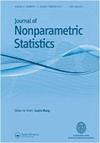Regression analysis of informatively interval-censored failure time data with semiparametric linear transformation model
IF 0.9
4区 数学
Q3 STATISTICS & PROBABILITY
引用次数: 6
Abstract
ABSTRACT Regression analysis of interval-censored failure time data with noninformative censoring has been widely investigated and many methods have been proposed. Sometimes the mechanism behind the interval censoring may be informative and several approaches have also been developed for this latter situation. However, all of these existing methods are for single models and it is well known that in many situations, one may prefer more flexible models. Corresponding to this, the linear transformation model is considered and a maximum likelihood estimation method is established. In the proposed method, the association between the failure time of interest and the censoring time is modelled by the copula model, and the involved nonparametric functions are approximated by spline functions. The large sample properties of the proposed estimators are derived. Numerical results show that the proposed method performs well in practical application. Besides, a real data example is presented for the illustration.半参数线性变换模型下信息间隔截尾失效时间数据的回归分析
失效时间间隔截割数据的非信息截割回归分析已经得到了广泛的研究,并提出了许多方法。有时,间隔审查背后的机制可能会提供信息,对于后一种情况也开发了几种方法。然而,所有这些现有的方法都是针对单一模型的,众所周知,在许多情况下,人们可能更喜欢更灵活的模型。与此相对应,考虑了线性变换模型,建立了极大似然估计方法。该方法将感兴趣的失效时间与检测时间之间的关系用copula模型来建模,所涉及的非参数函数用样条函数来逼近。给出了所提估计量的大样本性质。数值结果表明,该方法具有较好的实际应用价值。并给出了一个实际的数据实例。
本文章由计算机程序翻译,如有差异,请以英文原文为准。
求助全文
约1分钟内获得全文
求助全文
来源期刊

Journal of Nonparametric Statistics
数学-统计学与概率论
CiteScore
1.50
自引率
8.30%
发文量
42
审稿时长
6-12 weeks
期刊介绍:
Journal of Nonparametric Statistics provides a medium for the publication of research and survey work in nonparametric statistics and related areas. The scope includes, but is not limited to the following topics:
Nonparametric modeling,
Nonparametric function estimation,
Rank and other robust and distribution-free procedures,
Resampling methods,
Lack-of-fit testing,
Multivariate analysis,
Inference with high-dimensional data,
Dimension reduction and variable selection,
Methods for errors in variables, missing, censored, and other incomplete data structures,
Inference of stochastic processes,
Sample surveys,
Time series analysis,
Longitudinal and functional data analysis,
Nonparametric Bayes methods and decision procedures,
Semiparametric models and procedures,
Statistical methods for imaging and tomography,
Statistical inverse problems,
Financial statistics and econometrics,
Bioinformatics and comparative genomics,
Statistical algorithms and machine learning.
Both the theory and applications of nonparametric statistics are covered in the journal. Research applying nonparametric methods to medicine, engineering, technology, science and humanities is welcomed, provided the novelty and quality level are of the highest order.
Authors are encouraged to submit supplementary technical arguments, computer code, data analysed in the paper or any additional information for online publication along with the published paper.
 求助内容:
求助内容: 应助结果提醒方式:
应助结果提醒方式:


